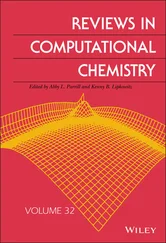Once the second shell is full at neon, the next electron at sodium ( Z = 11) enters the third shell and occupies the 3s orbital. The filling process is then repeated as for the second row of elements. The electron arrangement for chlorine ( Z = 17) is shown in Figure 1.10. Table 1.4shows how electrons fill atomic orbitals for the first 36 elements – i.e. up to the end of the fourth row of the periodic table.
Table 1.4Electron configurations for the first 36 elements.
| Element symbol |
Atomic number |
n = 1 shell |
n = 2 shell |
n = 3 shell |
n = 4 shell |
|
|
1sH |
2s1 |
2p1 |
3s |
3p |
3d |
4s |
4p |
| He |
2 |
2 |
|
|
|
|
|
|
|
| Li |
3 |
2 |
1 |
|
|
|
|
|
|
| Be |
4 |
2 |
2 |
|
|
|
|
|
|
| B |
5 |
2 |
2 |
1 |
|
|
|
|
|
| C |
6 |
2 |
2 |
2 |
|
|
|
|
|
| N |
7 |
2 |
2 |
3 |
|
|
|
|
|
| O |
8 |
2 |
2 |
4 |
|
|
|
|
|
| F |
9 |
2 |
2 |
5 |
|
|
|
|
|
| Ne |
10 |
2 |
2 |
6 |
|
|
|
|
|
| Na |
11 |
2 |
2 |
6 |
1 |
|
|
|
|
| Mg |
12 |
2 |
2 |
6 |
2 |
|
|
|
|
| Al |
13 |
2 |
2 |
6 |
2 |
1 |
|
|
|
| Si |
14 |
2 |
2 |
6 |
2 |
2 |
|
|
|
| P |
15 |
2 |
2 |
6 |
2 |
3 |
|
|
|
| S |
16 |
2 |
2 |
6 |
2 |
4 |
|
|
|
| Cl |
17 |
2 |
2 |
6 |
2 |
5 |
|
|
|
| Ar |
18 |
2 |
2 |
6 |
2 |
6 |
|
|
|
| K |
19 |
2 |
2 |
6 |
2 |
6 |
|
1 |
|
| Ca |
20 |
2 |
2 |
6 |
2 |
6 |
|
2 |
|
| Sc |
21 |
2 |
2 |
6 |
2 |
6 |
1 |
2 |
|
| Ti |
22 |
2 |
2 |
6 |
2 |
6 |
2 |
2 |
|
| V |
23 |
2 |
2 |
6 |
2 |
6 |
3 |
2 |
|
| Cr |
24 |
2 |
2 |
6 |
2 |
6 |
5 |
1 |
|
| Mn |
25 |
2 |
2 |
6 |
2 |
6 |
5 |
2 |
|
| Fe |
26 |
2 |
2 |
6 |
2 |
6 |
6 |
2 |
|
| Co |
27 |
2 |
2 |
6 |
2 |
6 |
7 |
2 |
|
| Ni |
28 |
2 |
2 |
6 |
2 |
6 |
8 |
2 |
|
| Cu |
29 |
2 |
2 |
6 |
2 |
6 |
10 |
1 |
|
| Zn |
30 |
2 |
2 |
6 |
2 |
6 |
10 |
2 |
|
| Ga |
31 |
2 |
2 |
6 |
2 |
6 |
10 |
2 |
1 |
| Ge |
32 |
2 |
2 |
6 |
2 |
6 |
10 |
2 |
2 |
| As |
33 |
2 |
2 |
6 |
2 |
6 |
10 |
2 |
3 |
| Se |
34 |
2 |
2 |
6 |
2 |
6 |
10 |
2 |
4 |
| Br |
35 |
2 |
2 |
6 |
2 |
6 |
10 |
2 |
5 |
| Kr |
36 |
2 |
2 |
6 |
2 |
6 |
10 |
2 |
6 |
Within Table 1.4, there are various points to note. Firstly, electron filling appears to follow the rules just listed up to element 18, argon, when the 3p orbitals are full. The next electron might be expected to occupy the first 3d orbital; however, it can be seen that the electron in potassium actually occupies the 4s orbital. The reason for this is that the energy of the electrons in a 4s orbital is slightly lower than the energy of the electrons in the 3d orbitals, because the 4s orbital is larger and more diffuse. This means the electron in potassium occupies the 4s orbital preferentially, giving potassium a single outer s electron and placing the element in the s block. The electron configuration of potassium is 1s 22s 22p 63s 23p 64s 1.
Secondly, the next electron at calcium also occupies the 4s orbital, giving an electron configuration of 1s 22s 22p 63s 23p 64s 2. However, once the 4s orbital is filled, the next electron at scandium occupies the first 3d orbital, as this is now lower in energy than the 4p orbitals.
A shorthand way to write electron configurations is to use the symbol for the noble gas element (Group 8) to represent electrons in filled shells. So the electron configuration for potassium, 1s 22s 22p 63s 23p 64s 1can be written as [Ar]4s 1, where [Ar] represents the configuration 1s 22s 22p 63s 23p 6.
Finally, you may notice another anomaly in filling atomic orbitals at Cr and Cu. These two elements have just a single 4s electron, whereas the preceding elements have a filled 4s shell. Cr has one electron in each of its 3d orbitals, and copper has two electrons in each 3d orbital, leaving just one 4s electron in each case. The usual reason given for this relates to the extra stability associated with having a filled or half‐filled set of d orbitals.
1.2.6 Electronic structures and the periodic table
The original organisation of elements in the periodic table was proposed by Mendeleev in 1869. This was before experiments had been carried out that proved the existence of atomic orbitals and energy levels in atoms. He organised the elements based on their atomic masses and other properties. It is now known that chemical reactivity depends upon electronic structure, so our current periodic table agrees with Mendeleev's. The periodic table consists of four main areas, which are generally shown shaded in different colours.
On the left hand of the periodic table are Groups 1 and 2. The elements in these groups are known as s block elements as their highest energy electrons are in s orbitals.
On the right of the periodic table are the p block elements. These constitute the elements in Groups 3–8 (or Groups 13–18) where the p orbitals are being filled.
In the middle section are the d block elements. This area includes 10 groups of elements from Sc to Zn in the first row of the d block. These elements are all metals and those in Groups 3-11 are often referred to as transition elements . The elements in the group headed by zinc (Group 12) are not transition elements.
At the bottom of the periodic table are the two rows of elements that form the f block . The elements in these two rows are called the lanthanides and actinides and have electrons filling the f orbitals. In total, f orbitals can hold 14 electrons, as there are 7f orbitals. A discussion of these orbitals is beyond the scope of this book.
Читать дальше












